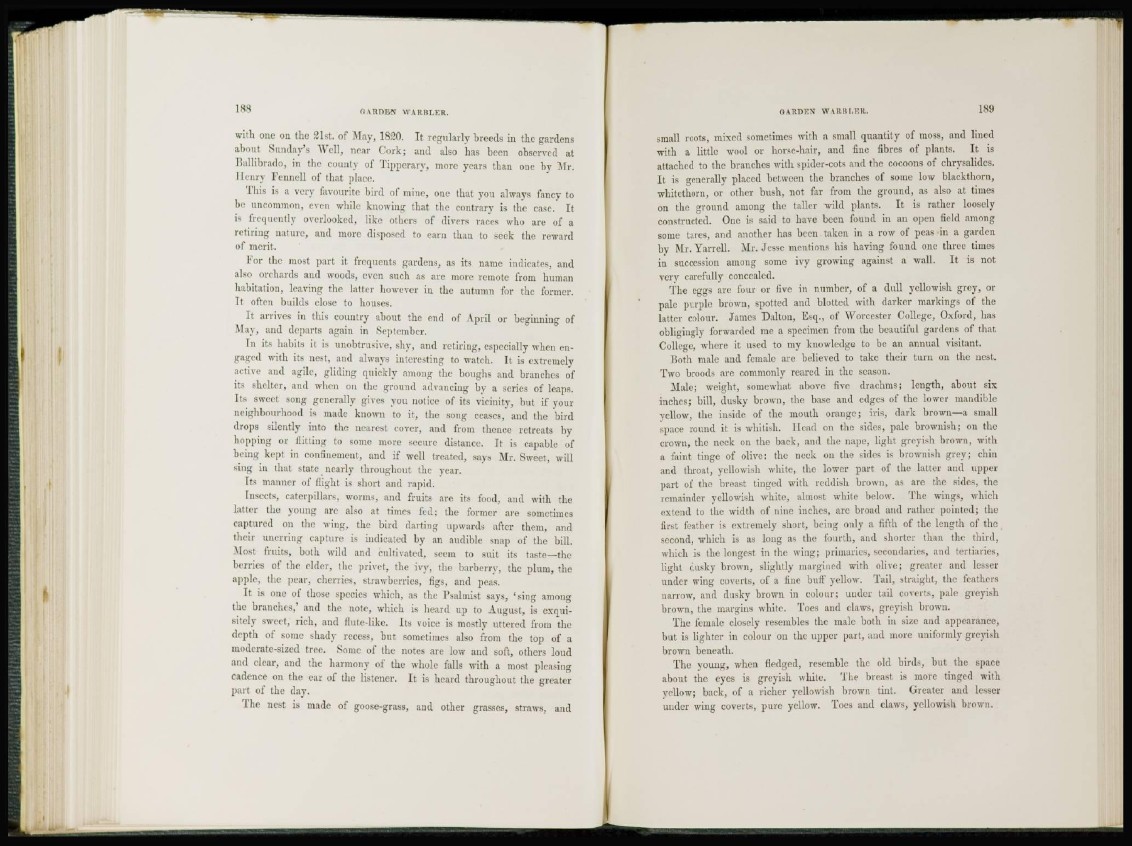
188 GABDBW WARBLER.
with one on the 21st. of May, 1820. It regularly "breeds in the gardens
about Sunday's Well, near Cork; and also has been observed at
Ballibrado, in the county of Tipperary, more years than one by Mr.
Henry Fcnnell of that place.
This is a verv favourite bird of mine, one that you always fancy to
be uncommon, even while knowing that the contrary is the case. It
is frequently overlooked, like others of divers races who are of a
retiring nature, and more disposed to earn than to seek the reward
of merit.
Eor the most part it frequents gardens, us its name indicates, and
also orchards and woods, even such as are more remote from human
habitation, leaving the latter however in the autumn for the former.
I t often builds close to houses.
It arrives in this country about the end of April or beginning of
May, and departs again in September.
I n its habits it is unobtrusive, shy, and retiring, especially when engaged
with its nest, and always interesting to watch. It is extremely
active aud agile, gliding quickly among the boughs and branches of
its shelter, and when on the ground advancing by a series of leaps.
I t s sweet song generally gives you notice of its vicinity, but if your
neighbourhood is made known to it, the song ceases, and the bird
drops silently into the nearest cover, and from thence retreats by
hopping or Hitting to some more secure distance. It is capable of
being kept in confinement, and if well treated, says Mr. Sweet, will
sing in that state nearly throughout the year.
Its manner of flight is short and rapid.
Insects, caterpillars, worms, and fruits are its food, and with the
latter the vnung are also at times fed; the former are sometimes
captured on the wing, the bird darting up wards after them, and
their unerring capture is indicated by an audible snap of the bill.
Most fruits, both wild and cultivated, seem to suit its taste—the
berries of the elder, the privet, the ivy, the barberry, the plum, the
apple, live pear, cherries, strawberries, figs, and peas.
I t is one of those species which, as the Psalmist says, ' s i n g among
the branches,9 and the note, which is heard up to August, is exquisitely
sweet, rich, and flute-like. Its voice is mostly uttered from the
depth of some shady recess, but sometimes also from the top of a
moderate-sized tree. Some of the notes are low and soft, others loud
and clear, and the harmony of the whole falls with a most pleasing
cadence on the ear of the listener. It is heard throughout the greater
part of the day.
The nest is made of goose-grass, and other grasses, straws, and
GARDEN W VRBI.FR. 189
small roots, mixed sometimes with a small quantity of moss, and lined
with a little wool or horse-hair, and fine fibres of plants. It is
attached to the branches with spider-cots and the cocoons of chrysalides.
I t is generally placed between the branches of some low blackthorn,
whitethorn, or other bush, not far from the ground, as also at times
on the ground among the taller wild plants. It is rather loosely
constructed. One is said to have been found in an open field among
some tares, and another has been taken in a row of peas in a garden
by Mr. Yarrell. Mr. Jesse mentions his having found one three times
in succession among some ivy growing against a wall. It is not
very carefully concealed.
The eggs are four or five in number, of a didl yellowish grey, or
pale purple brown, spotted aud blotted with darker markings of the
latter colour. James Dalton, Esq., of Worcester College, Oxford, has
obligingly forwarded me a specimen from the beautiful gardens of that.
College, where it used to my knowledge to be an annual visitant.
Both male and female are believed to take their turn on the nest.
Two broods are commonly reared in the season.
Male; weight, somewhat above five drachms; length, about six
inches; bill, dusky brown, the base and edges of the lower mandible
yellow, the inside of the mouth orange; iris, dark brown—a small
space round it is whitish. Head on the sides, pale brownish; on the
crown, the neck on the back, and the nape, light greyish brown, with
a faint tinge of olive: the neck on the sides is brownish grey; chin
and throat, yellowish white, the lower part of the latter and upper
part of the breast tinged with reddish brown, as are the sides, the
remainder yellowish wdiite, almost white below. The wings, which
extend to the width of nine inches, arc broad and rather pointed; the
first feather is extremely short, being only a fifth of the length of the
second, which is as long as the fourth, and shorter than the third,
which is the longest in the wing; primaries, secondaries, and tertiaries,
light dusky brown, slightly margined with olive; greater and lesser
under wing coverts, of a fine buff yellow. Tail, straight, the feathers
narrow, and dusky brown in colour; under tail co-verts, pale greyish
brown, the margins white. Toes and claws, greyish brown.
The female closely resembles the male both iu size and appearance,
but is lighter in colour on the upper part, aud more uniformly greyish
brown beneath.
The young, when fledged, resemble the old birds, but the space
about the eyes is greyish white. The breast is more tinged with
yellow; back, of a richer yellowish brown tint. Greater and lesser
under wing coverts, pure yellow. Toes aud claws, yellowish brown.